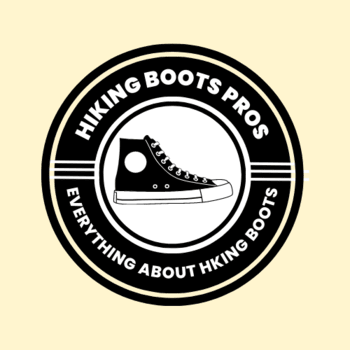Last updated on May 8th, 2023
Are hiking boots slip-resistant? When it comes to outdoor activities, proper gear is essential for a safe and comfortable experience. Hiking boots are a crucial part of any hiker’s equipment, but are they slip-resistant?
In this blog post, we will explore the basics of traction, the importance of slip resistance in hiking boots, and what features to look for in slip-resistant hiking boots.
Are Hiking Boots Slip-Resistant?

The short answer is yes, hiking boots can be slip-resistant. However, not all hiking boots are created equal. Different types of hiking boots have varying levels of slip resistance depending on their sole materials, tread pattern, and construction.
It’s important to choose the right type of hiking boot for your specific needs, taking into account the terrain and weather conditions you’ll be hiking in.
What are The Basics of Traction?
When it comes to hiking, good traction can make a world of difference. Traction refers to the ability of your shoes to grip the ground and keep you stable on uneven surfaces. Without proper traction, it’s easy to slip and fall, especially when hiking on rocky, muddy, or steep terrain.
Definition of Traction
Traction is the measure of a shoe’s ability to grip the ground and provide stability. When it comes to hiking boots, traction is especially important to prevent slips and falls on slippery terrain.
Factors that Affect Traction
There are several factors that affect a shoe’s traction, including the sole material, tread pattern, and the overall design of the shoe. The terrain and weather conditions also play a significant role in a shoe’s ability to provide traction.
Different Types of Sole Materials and Their Traction
There are several types of sole materials used in hiking boots, including rubber, synthetic, and leather. Rubber soles are the most popular hiking boots due to their superior grip and durability.
What is The Importance of Slip Resistance in Hiking Boots?
When it comes to hiking, slip resistance is an essential factor that should not be overlooked. A good pair of hiking boots with proper slip-resistant soles can make a big difference between a safe hike and a hazardous one.
How Slip Resistance is Measured
Slip resistance is measured by various tests that determine a shoe’s ability to grip the ground in wet and dry conditions. The most common test used to measure slip resistance is the coefficient of friction test.
Prevent Injuries on the Trail
Slip-resistant hiking boots are essential to prevent injuries on the trail. Falls can lead to serious injuries, especially in remote areas where medical assistance may be difficult to obtain.
Benefits of Slip-Resistant Hiking Boots
The benefits of slip-resistant hiking boots are numerous. They provide better stability and grip on uneven terrain, reduce the risk of slipping and falling, and offer overall comfort and support during long hikes.
What Features to Look For in Slip-Resistant Hiking Boots?
When it comes to slip-resistant hiking boots, there are certain features that you should look for to ensure maximum safety and comfort on the trail. Let’s explore some of these features in detail.
Deep and Multidirectional Lugs
Lugs are the protrusions on the sole of the boot that provide traction and grip on various surfaces. Deep and multidirectional lugs are essential for slip-resistant hiking boots as they help to increase the surface area in contact with the ground, providing better grip and stability on rough terrains. The deeper and more multidirectional the lugs, the better the traction will be.
Rubber Compounds for Better Grip
Rubber compounds used in the sole of hiking boots also play a significant role in providing slip resistance. Different types of rubber compounds offer varying degrees of grip and durability, which is why it’s important to choose a pair of hiking boots with high-quality rubber compounds. Vibram, for instance, is a popular brand known for its excellent rubber compounds, offering superior grip on wet and dry surfaces.
Advanced Traction Technologies
Hiking boot manufacturers are constantly developing new technologies to enhance slip resistance. Some of the latest traction technologies include Gore-Tex Surround, which provides breathability and waterproofing, and Spider Rubber, which is known for its exceptional grip and durability.
These advanced technologies can significantly improve the slip resistance of hiking boots, making them safer and more reliable on the trail.
How to Test Hiking Boots for Slip Resistance?
Choosing the right pair of slip-resistant hiking boots can make all the difference in your outdoor experience. Here are some ways to test the slip resistance of hiking boots:
The wet Traction test involves walking on a wet surface and observing how much slip resistance the boots provide. Look for boots with multidirectional lugs and high-quality rubber compounds for better performance.
Next is Incline Test, Walking uphill and downhill on various terrains can help test the grip of the hiking boots. Make sure the boots have deep and multidirectional lugs and advanced traction technologies to provide maximum grip and stability.
The slip Test involves walking on a slippery surface to test the slip resistance of the boots. Look for boots with advanced technologies and high-quality rubber compounds to ensure maximum safety on slippery surfaces.
Know more about: How long should I wear hiking boots
Conclusion
In conclusion, when it comes to hiking boots, slip resistance is an essential feature that cannot be overlooked. Understanding the basics of traction, the importance of slip resistance, and what features to look for in slip-resistant hiking boots can help you choose the right footwear for your next hiking adventure.
Whether you’re a seasoned hiker or a beginner, investing in slip-resistant hiking boots can ensure a safe and enjoyable hiking experience. Always remember to test your boots for slip resistance before hitting the trails.
FAQs
While slip-resistant shoes can be helpful for hiking, it is generally recommended to use hiking boots, which are designed specifically for the rigors of hiking.
Look for hiking boots that have soles made of durable rubber or other materials that are designed to provide traction on various surfaces. Some brands may also indicate on the packaging or product description if the boot is slip-resistant.

Tyler Looney is an avid hiking enthusiast and the author of HikingBootsPros.com, a website dedicated to providing helpful insights and advice on choosing the best hiking boots. His expertise and passion for hiking have made him a valuable resource for both beginner and experienced hikers alike.

